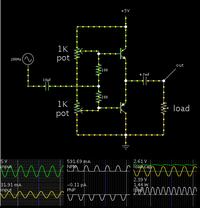abdulmakhdoom
Member level 2

post the 3w or 5w or 10w amplifier circuit from 5v source.
Follow along with the video below to see how to install our site as a web app on your home screen.
Note: This feature may not be available in some browsers.



post the 3w or 5w or 10w amplifier circuit from 5v source.






This is a very simple H-bridge audio amplifier.
With a 5V supply, it can deliver over 9V peak-to-peak (if the incoming waveform has sufficient amplitude).
It wastes over 300 mA when there is no signal. It will take some additional circuitry to remedy this.
Hi
I've designed this circuit for handling out put power , of 20Watts ( something around it ! ) .......

Originally Posted by rohitkhanna
...
How about a class-D config driving a H-bridge - for better efficiency ?

Hi rohitkhannaThis doesn't work off +5v... its using a +/- 15v power source !!
A question , why for such a low power , rating we should design a class D amplifier ? that's not economic for 10 watts !How about a class-D config driving a H-bridge - for better efficiency ?

Read post#1 again please.Hi rohitkhanna
Why you think the circuit should work with 5 volts ? what is the benefit of a 5 volts supply ? . the original poster didn't mention the supply rating before .
And another point is you can decrease supply voltage of my circuit too ! so that's not a problem .
A question , why for such a low power , rating we should design a class D amplifier ? that's not economic for 10 watts !
However it has pretty low THD and much better efficiency but i think price is important !

Yes you're absolutely right . i didn't see the end of his sentence and it is very fun ! ha ha !Read post#1 again please.
Again You're quite right . but it is not a problem ! because he/she can use a push pull amplifier to increase the out put voltage with taking more current ! so main supply can be 5 volts but out put voltage can be higher !Your circuit uses TL072 which are not rated for supply voltages below 7v, so it will not work with 5v. Secondly, even if you found opamps to work at sub-5v supply, your biasing scheme for output bjt's will need modifications. Lastly, your design works using split supply - while we are discussing single supply options.
I hope you know about limitations of a Class D amplifier . there are gang of reasons that why a class D amplifier isn't good choice with 5 volts supply !Because the OP asked for +5v supply & 3/5/10 watts operation.

.....use a push pull amplifier to increase the out put voltage with taking more current ! so main supply can be 5 volts but out put voltage can be higher ! ...
I hope you know about limitations of a Class D amplifier . there are gang of reasons that why a class D amplifier isn't good choice with 5 volts supply !

Hi againNote that the output voltage is NOT 'higher'
please enlighten us ? Other than design of LC filter matched to the speaker - which is of course critical - what are the other issues? I would think that at such low voltages, with proper use of selected MOSFETS, the class-D would probably be the most cost efficient in terms of Audio-Watts/ Cost/ Power consumed.



I need a simple npn or pnp transisor based amplifier having load or output is 4ohm (1 or 3 or 5w) with +5v supply.........




Hi againwithout transformer......

Hi again
That's impossible to achieve this power rating with 5 volt supply and a 4 ohm load without transformer !
Good Luck
Goldsmith